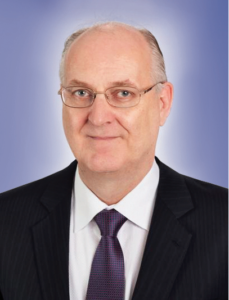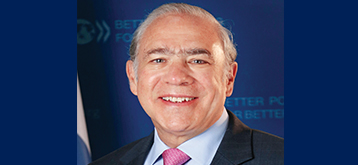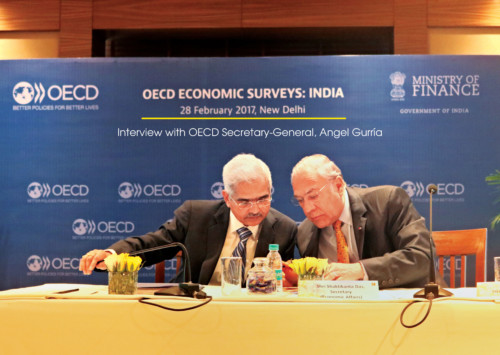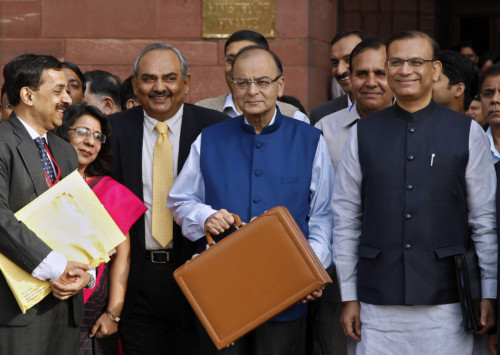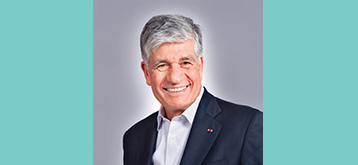Paul Sheard
Biz@India
June 2017
Brexit and Trump are the two main disruptions for 2017, and the world will have to keep an eye out to see how exactly they will react and affect the economy, says Sheard.
Paul Sheard, the executive vice president and chief economist at S&P Global, goes deep to find the root causes of the state of the current world economy in a conversation with Biz@India.
What’s your view on 2017? What surprises would it have? Where is the global economy headed?
It’s very difficult to predict surprises in advance. So I better focus on what are the challenges and potential pain points. The overall outlook is quite constructive this year. It should be a little bit faster than last year. The United States of America (US) did pick up in first half of the last year. So even forgetting about the Trump economics, the US should pick up growth at 2.4 pc. Some economies are coming out of recession like Brazil and Russia. They have had couple of years of very deep recession. We should get some growth there. Also, it has been a very supportive year of monetary and fiscal policy in Japan. We think the Euro is on, and in the United Kingdom (UK) despite Brexit, there will be some headwinds but we won’t have collapse of growth. So adding it all up, we don’t have a bad picture. But it is obviously 2017. The interesting points to focus on are the shocks of 2016 playing out in 2017.
Brexit and Trump. As far as Brexit goes, that will be a normal slow moving issue. There may be some bumps along the road. But it’s more of a chronic process, that will reveal bit by bit, rather than being a cliff. If there is a cliff it might be in two years’ time. That’s not an issue of 2017. The most interesting issues revolve around the incredible political and policy shift in US with the Trump administration. There, it’s still very early days, but the band of uncertainty has broadened, the distribution of outcomes has become little bit more bimodal than normal. In other words, US President Trump is a disruptor, an innovator and unconventional. Also the Republicans have unified government there. The potential for policy to move is much higher. As far as having a unified government, the Congress and White House is in Republican hands, you have a very activist, high energy President. So that means lots will happen. The question is will those things be positive or will they break the china and be very negative. It’s really too early to say with any certainty, but over the course of the year, we will find answer to that question.
Any other bright spots for 2017 besides the US?
One bright spot is Japan. Japan’s potential growth is quite low, because of the demographics, but Japan is in 3rd and entering into 4th year into this grand experiment of Abenomics, the experiment was monetary policy. Well, the Federal is now raising interest rates, and Japan has put in place a completely unconventional policy framework of quantitative easing with yield curve control and they still have a negative overnight interest. Fiscal policy is now being supportive of monetary policy; not working against it. So, really for the first time in many years, there is a potential inflation to surprise a little bit on the outside. So it wouldn’t be dramatic, but it could see a shift in the kind of way people look at Japan, which could be an interesting theme developing over the course of a year. That’s worth watching. Another bright spot is potentially India. But there is now the confounding factor of the currency swap. The demonetisation has caused to take a percentage point off growth forecast of India, but it still is a considerable growth – close to seven pc. So India is one of the economies that has been, since the financial crisis in particular, delivering consistently very high growth and reforms. The demonetisation seems part of that reform, but in macroeconomic terms it is a contractionary force. But India, given its large population, on purchasing power parity basis, India is the third largest economy in the world. If you have the third largest economy in the world growing close to seven pc that’s a bright spot. India has a tremendous economic development potential. So that is a long way to go. I think the growth bright spots, a relative bright spot may be UK, in the sense that, the forecasting was 1.4 pc; before Brexit, the forecasting was 1.9 pc. We had brought that number down to 0.9 pc, now it’s back to 1.4 pc what that says is that so far at least the potential adverse shocks from Brexit haven’t come through. So, if the UK economy does spiral, all the negotiations which will make it noisy in the second half of the year, I will probably count it as a positive outcome.
What about the Gulf region, the energy prices, where do you see that?
Oil prices will trend up a little bit over time. We think its upward trend is capped by the whole change in the energy market, the shale revolution. We see the energy markets as a quiet fourth industrial revolution. Technology has driven a fundamental shift in the structure of energy market. The days of USD 100 crude are gone, they will never come back in the foreseeable future. But at the same time, oil growth is fairly robust. Many of the Gulf States of course, United Arab Emirates (UAE), Saudi Arabia are focusing on diversifying their economy. The message has really got through that they have to diversify their economies moving more into high value added services. Some of the economies are doing that quite successfully.
Do you think World Trade Organization (WTO) is facing an existential threat?
I wouldn’t put it that strongly. We saw two leaders of the world,President Xi Jinping of China and Prime Minister Theresa May of UK, the two keynote speakers of Davos, both of them put down very firm plank of support for globalisation and free trade. So that’s good news from the view point of WTO.
Much more attention has to be paid to the losers from globalisation, to the people who are left behind, from the middle classes that have dropped out into the working classes.
What could go wrong in 2017?
The things we have sort of been talking about and some other things we aren’t focusing on. I am putting aside geopolitical issues and cyber-attacks. One is simply that the Trump administration does not succeed. It doesn’t develop a coherent economic package. If you look at the Trump administration, it’s not long on economists. Trump doesn’t seem to have a natural affinity for economists; that’s fine. Important thing is whether policies that come out are coherent policies. The supply side reforms, rolling back excessive regulation, stimulus infrastructure, rebuild and modernise infrastructure, tax cuts, etc., and not becoming protectionist with trade. If you reverse all of that, that’s the coming to the road to perdition. In other words, no-one could go wrong there if we swing the pendulum back in other direction, in terms of financial de-regulation. This is not something that will happen this year
From some people you will hear voices of concern that we are unlearning the lessons of financial crisis. We don’t want to unlearn. We want to learn the lessons. We want to fine-tune the lessons. On the macro side, interesting set of issues here will be how the Federal Reserve fits into the Trump economic framework. Logically, Trump administration does everything it has been talking about in terms of stimulating the economy. It is talking about creating growth of 3-4 pc. Now that goes against the grain of conventional economic thinking, which shows that potential growth might be two pc. TheTrump administration says we want the growth to be 3-4 pc but the speed limit of the economy once we reach full employment is actually two pc. Maybe with some things you get to turn up half pc with some spirit, innovation, investment, but you can’t get to four pc. Otherwise, you’ll start to get inflationary pressure.
Then the Federal Reserve’s job is to act against that and start hiking interest rates. How will Trump respond to that? The normal way would be to say that the Federal Reserve is doing its job. Don’t blame the Federal Reserve. But you could see a nasty situation developing between the government, the Federal Reserve and the Congress. You call that independence of the Federal Reserve being under threat. If that will happen, if the markets were to perceive that the Federal Reserve is being completely politicised, it might react negatively. For example in 70s or something like that, the market responded adversely. That’s a potential risk to all the biggest financial market in the world – the treasury market. Of course, we have the risk on the trade side as well.
The other set of risks is in Europe. We have these major elections this year, Germany, France, Netherlands, Italy, and we have the Brexit. So Brexit will have to be addressed the same year you have these major elections. So the big question out there is, whether the Europeans can deal with that in a way that maintains confidence and doesn’t interfere with the recovery. I am not making comments on electoral results per say. That’s democracy. It’s more whether Europeans will be able to deal with Brexit with the clear need to deliver more growth in Europe. And that will require at some point further developing the whole European economic, monetary, political framework or at least using it more flexibly to deliver growth. Otherwise, you will get some kind of atmosphere of acrimony, almost policy and political incoherence taking over.
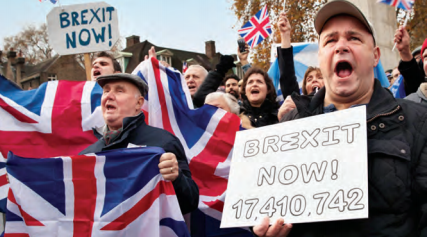
Brexit and Trump administration are the two factors to look out for in the shifting economic landscape
Do you think the central bankers are under pressures and taking up the point of politicisation? Look at the Reserve Bank of India, do you think they are acting as a central banker or more like a political outfit?
Certainly you would see more pressure coming up as populist leaders get elected.
I think it’s a very important and interesting question. I won’t comment on Reserve Bank of India. That has developed very well in the last few years under the leadership of Raghuram Rajan, and it seems to be going in good direction. But there are bigger issues. Just forget about Trump and everything else for the moment. We have learnt a lot of lessons in last six to seven years. About the macroeconomic policy framework: putting this idea of technocratic independent central banks with inflation targeting frameworks on a macroeconomic policy pedestal that may have gone too far.
The way my own thinking has evolved is that there are three key silos of policy. One is macroeconomic demand policy, managing demand, the job there – whatever the supply potential is – is to keep demand in line with that, neither too little nor too much. Second is supply side policy, structural reforms, deregulation, and institutional frameworks. Thirdly, we have the financial systems. Those three pillars of policy, they all kind of inter-relate in certain ways and also they are somewhat independent. If you look at division of labour, it is a little bit more, because of the structural policy. Then it’s clearly the role of government. If you look at the macroeconomics demand management policy, coming into the crisis, the idea became just leave that to central banks.
But what about fiscal policy? Fiscal policy is still with the government not with the central banks. It’s a strange thing. It’s okay running there, if you believe that really fiscal policy shouldn’t be used on macroeconomic demand management. Then you can leave that with the government and leave the demand management with central bank. But what if your world is de-leveraging world, where there is a sudden loss of aggregate demand, so you want that aggregate demand to get back into the system quickly. Monetary policy doesn’t work very well. Fiscal policy – particularly direct government expenditures – consumption, investment, can be much effective if that is paired with monetary policy.
Even last year we got into the discussion of helicopter money. We didn’t go there because the economy improved, but that started to come into the field of vision. The lesson was maybe fiscal policy has a bigger role to play in macroeconomic demand management and it needs to be more closely coordinated with monetary policy. So I think, this whole thing needs to be rethought in a broader framework of not just thinking in terms of independence of central bank – is that under threat , and is the central bank being politicised – to thinking more in terms of what is the right co-relation of demand management policy. And how the fiscal and monetary talk to one another and fit together.
Will Trump stumble into that in some way? Sometimes people, who don’t have any vested interest in the system, don’t know the norms of that system, can sort of ask the silly questions. So you don’t want to see the professionalism, the very high level of policy competence at the Federal to be eroded but you want to see a slightly broader perspective and mobilisation of policy expertise between the different branches. When it comes to the financial system, the stability is almost by its nature – an area where the government and the fiscal interact with the monetary and supervisory role of the central bank. My view is we shouldn’t have too much of knee-jerk reaction around the concept of independence. We need to think about in that framework of policy and more policy coordination: whether the policy framework is well specified, robust and acting in the service of the political goals of the country.

